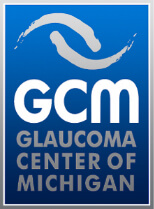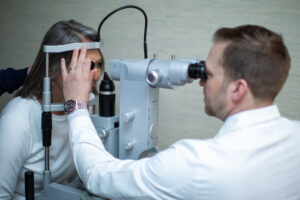
Glaucoma treatment involves increasing aqueous humor outflow or decreasing aqueous humor production, resulting in the lowering of the intraocular pressure (IOP) to help prevent damage to the optic nerve within the eye. The three main types of treatment to lower the IOP are medical therapy, laser treatment, and surgery. In regard to glaucoma surgery, there are traditional options such as trabeculectomy and tube shunts as well as a set of less invasive procedures classified as Micro-Invasive Glaucoma Procedures (MIGS for short). Some such as ECP have been done routinely for many years at Glaucoma Center of Michigan, others have been developed more recently. You can read more about these surgical options here.
Medical treatment consists mainly of drugs that are delivered to the eye by drops. Eye drops have the advantage of delivering the highest possible dose of medication directly to the eye while minimizing any side effects to the rest of the body. Pressure within the eye is determined by the balance between the amount of fluid that the eye produces and the rate at which it drains through the trabecular meshwork. Medications either reduce the production of fluid (affecting inflow) or increase the rate at which fluid drains (outflow). There are many different drops that can be used in various combinations and your doctor will work with you to determine what is optimal for your situation.
Lasers are used frequently for glaucoma treatment, with common types including the Selective Laser Trabeculoplasty (SLT), laser peripheral iridectomy (LPI), Micropulse® Diode Cyclophotocoagulation (MP3) and traditional Trans-Scleral Cyclophotocoagulation Diode Laser (TSCPC). SLT laser improve the outflow of fluid, thus lowering the IOP. LPI is done to help reduce narrowing of the anterior angle to help the aqueous fluid have better access to the trabecular meshwork drainage system. MP3® and TSCPC lasers are externally applied and work by decreasing the amount of intraocular fluid (aqueous humor) produced within your eye to lower the IOP; TSCPC is generally utilized for more advanced glaucoma. Some patients have laser treatment as their primary method of controlling their glaucoma while others have this done in combination with eye drops. Laser treatment is performed in the office (SLT or LPI) or the operating suite (MP3® and TSCPC) and generally allows a rapid return to normal daily activities.

Treatment varies depending on the type of glaucoma. Chronic open angle and secondary glaucoma are usually treated with a combination of one or more eye drops or ointment. The drops are instilled between one and four times a day. Using eye drops is frequently a lifetime commitment. If eye drops inadequately control the pressure, glaucoma pills or a laser may be necessary. If all else fails, glaucoma surgery in the operating room can be performed. Angle closure glaucoma requires a laser treatment (laser iridectomy). Congenital glaucoma requires immediate surgery in the operating room.
Lasers have been used since the late 1970’s in the treatment of glaucoma. The laser performs in a number of different ways to decrease pressure in the eye: it can perforate, stretch, or remove a portion of tissue in the eye that is causing the pressure to increase. Laser treatment has proved to be very successful, safe, and effective in most types of glaucoma. Many times it prevents the need for conventional surgery and may even reduce the patient’s need to continue other glaucoma medications. Although laser surgery helps prevent further eye damage by relieving the built-up pressure, it cannot restore vision that has already been lost. Glaucoma patients receive many benefits from laser treatment. The treatment is usually done on an outpatient basis in the doctor’s office. This means that the patient is able to return home and resume normal activities following completion of the treatment (usually about 15 minutes). In addition, laser treatment requires no incision or after-laser patching. Only anesthetic drops are needed prior to the treatment.
Three types of laser surgery are used in the control and treatment of glaucoma. Generally, they are performedwith an Argon, SLT or YAG laser.

A laser trabeculoplasty in chronic open angle or secondary glaucoma is performed by stretching a portion of the trabecular meshwork, thus enabling fluid to drain more freely from the eye.
A laser iridotomy is performed for patients with narrow angles or angle closure by opening a pathway for fluid to flow through the iris. This is done by focusing the laser beam on the iris and making a tiny hole in the iris to create new drainage paths.
A laser iridoplasty is performed for patients who have components of both chronic open angle and narrow angle glaucoma. The laser is applied to the peripheral iris to “pull” it away from the trabecular meshwork (drainange canal).

More recently, special lasers have been utilized to treat otherwise unresponsive types of glaucoma. The purpose of these laser treatments is to destroy the ciliary body, the fluid producing tissue within the eye. In spite of the many improvements in treatment for patients with glaucoma, some patients still require surgical intervention. There are many different types of procedures classified as glaucoma filtration procedures. In all these procedures, the trabecular meshwork is removed to create a new drainage mechanism for the fluid to drain within the eye. They are frequently performed under local anesthesia on an outpatient basis. Following the surgery, patients are discharged from the hospital and return to the physician’s office the next day.